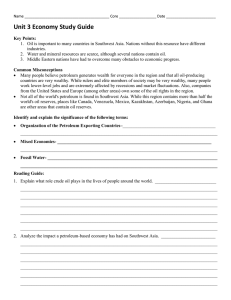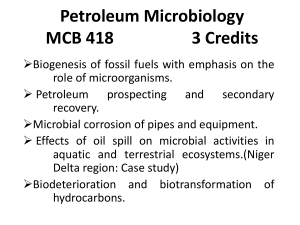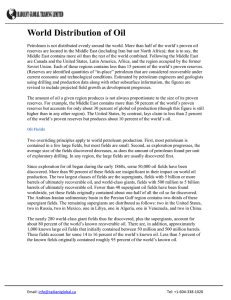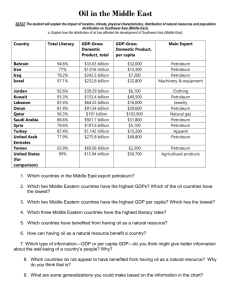techniques have been used for many years in functional
advertisement
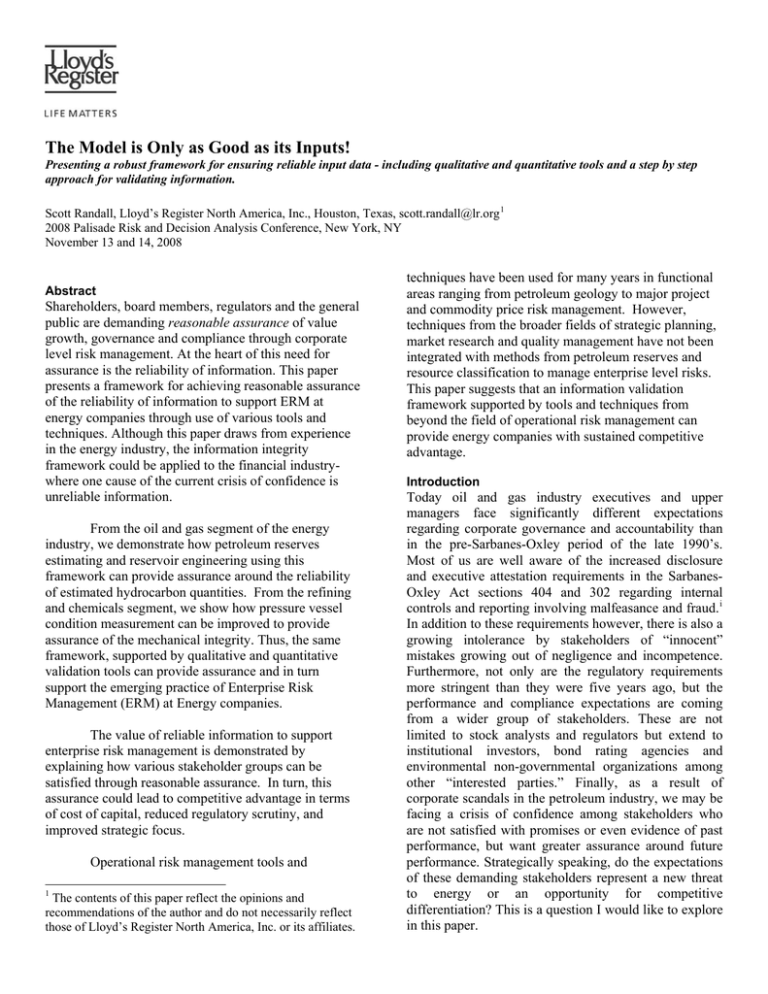
The Model is Only as Good as its Inputs! Presenting a robust framework for ensuring reliable input data - including qualitative and quantitative tools and a step by step approach for validating information. Scott Randall, Lloyd’s Register North America, Inc., Houston, Texas, scott.randall@lr.org 1 2008 Palisade Risk and Decision Analysis Conference, New York, NY November 13 and 14, 2008 Abstract Shareholders, board members, regulators and the general public are demanding reasonable assurance of value growth, governance and compliance through corporate level risk management. At the heart of this need for assurance is the reliability of information. This paper presents a framework for achieving reasonable assurance of the reliability of information to support ERM at energy companies through use of various tools and techniques. Although this paper draws from experience in the energy industry, the information integrity framework could be applied to the financial industrywhere one cause of the current crisis of confidence is unreliable information. From the oil and gas segment of the energy industry, we demonstrate how petroleum reserves estimating and reservoir engineering using this framework can provide assurance around the reliability of estimated hydrocarbon quantities. From the refining and chemicals segment, we show how pressure vessel condition measurement can be improved to provide assurance of the mechanical integrity. Thus, the same framework, supported by qualitative and quantitative validation tools can provide assurance and in turn support the emerging practice of Enterprise Risk Management (ERM) at Energy companies. The value of reliable information to support enterprise risk management is demonstrated by explaining how various stakeholder groups can be satisfied through reasonable assurance. In turn, this assurance could lead to competitive advantage in terms of cost of capital, reduced regulatory scrutiny, and improved strategic focus. Operational risk management tools and 1 The contents of this paper reflect the opinions and recommendations of the author and do not necessarily reflect those of Lloyd’s Register North America, Inc. or its affiliates. techniques have been used for many years in functional areas ranging from petroleum geology to major project and commodity price risk management. However, techniques from the broader fields of strategic planning, market research and quality management have not been integrated with methods from petroleum reserves and resource classification to manage enterprise level risks. This paper suggests that an information validation framework supported by tools and techniques from beyond the field of operational risk management can provide energy companies with sustained competitive advantage. Introduction Today oil and gas industry executives and upper managers face significantly different expectations regarding corporate governance and accountability than in the pre-Sarbanes-Oxley period of the late 1990’s. Most of us are well aware of the increased disclosure and executive attestation requirements in the SarbanesOxley Act sections 404 and 302 regarding internal controls and reporting involving malfeasance and fraud. i In addition to these requirements however, there is also a growing intolerance by stakeholders of “innocent” mistakes growing out of negligence and incompetence. Furthermore, not only are the regulatory requirements more stringent than they were five years ago, but the performance and compliance expectations are coming from a wider group of stakeholders. These are not limited to stock analysts and regulators but extend to institutional investors, bond rating agencies and environmental non-governmental organizations among other “interested parties.” Finally, as a result of corporate scandals in the petroleum industry, we may be facing a crisis of confidence among stakeholders who are not satisfied with promises or even evidence of past performance, but want greater assurance around future performance. Strategically speaking, do the expectations of these demanding stakeholders represent a new threat to energy or an opportunity for competitive differentiation? This is a question I would like to explore in this paper. 2 To appreciate the complexity of managing stakeholder expectations, the following table shows results of a high level stakeholder analysis for a hypothetical petroleum company with domestic and international exploration and production operations. Table 1-Petroleum Company Stakeholder Analysis Results Stakeholder Interest Attitude Sensitivity Power Board of Governance, Positive Medium High Directors Financial Results Securities Disclosure, Skeptical Medium MedExchange Financial ium Commission Compliance (SEC) Other Regulatory Indifferent Medium MedRegulators Compliance; ium Public Welfare Stock Short Term Positive Medium MedAnalysts Earnings, ium Dividends, Valuations, Reputation Credit Rating Liquidity, Skeptical High MedAgencies Debt Service ium Capacity Auditors Compliance Skeptical High Medium Institutional Future Positive High MedInvestors Earnings, ium Dividends, Individual Share price Positive Medium MedInvestors growth, ium dividends, disclosure EnvironAir, water, Negative Low Medmental land ium NGOs pollution, “responsible care”, minimal growth Host Country Legal Positive Medium MedGovernment Compliance, ium Investment, Local Content Of course each company will have different assessments based upon their specific circumstances. Even so, the pro-forma analysis represented in Table 1 identifies what could be the interests, attitudes, sensitivities and stakeholder power (or influence) of 10 potentially interested groups, (or stakeholders) regarding corporate, or enterprise level decisions. In spite of the 2008 Palisade Risk and Decision Analysis Conference North America variety and complexity of issues, the common thread among them is the need for assurance. To satisfy this need is where risk management comes into play. Furthermore, because many of the expectations involve corporate level commitments, the corresponding risks of non-compliance are corporate, or enterprise level risks. For example, when a bond rating agency puts a company on credit watch due to liquidity concerns, this can negatively affect both the equity and debt side of a company’s balance sheet as investors lose confidence and lenders increase borrowing rates. A contemporary example on the debt side is the increased number of corporate bonds that have become distressed over the past 6 months. 2 Finally, because many of these stakeholders are concerned with achievement of financial results, the assurance of the reliability of information feeding the forecast of earnings, cash flows and asset valuation is paramount. Achieving this assurance among powerful stakeholders is the major theme of this paper. Reliability and Information Validation How can the reliability of information be tested and validated? This is a very interesting question which has haunted me for nearly 20 years. Over the past few years, what I’ve found in the research supporting my book ii is that there is no definitive standard or framework for testing the reliability of information. I have looked as far as the fields of journalism, mechanical equipment performance forecasting, financial statement auditing, marketing research and commodity price forecasting. Each field offers piecemeal approaches and tools to address this perplexing problem, but none provides a framework for validation and testing. Having said this, the SPE’s Petroleum Resource Management System and the accompanying Guidelines for the Evaluation of Petroleum Reserves and Resources do provide interesting and useful guidance for estimating inherently uncertain petroleum resource volumes and values. iii, iv v Of particular note are the four analytical procedures and two estimating methods that are recommended in Section 4.0 of the Petroleum Management System. These at least provide common guidance for both the estimator and the auditor. Acceptable practices are described for estimating resource volumes and values. In turn, these directly affect the forecast of earnings, future cash flows and asset valuations. Even with these guidelines, a generalized approach or framework for information validation would be helpful. Tools and techniques to validate the raw data would also be useful to provide assurance to internal and external 2 Distressed (or “junk” bonds) are defined as those whose yield to maturity is 1,000 or more basis points over US Treasury notes of the same tenor. Palisade North America Conference stakeholders. An Information Validation Process Given the absence of any common approaches or standards, I propose a framework that involves a three stage secondary information validation process. The stages are: initial data screening, basic validation and advanced validation. The term “secondary” information as used here means data drawn from a process other than first hand observation or measurement. Thus, what is first hand (or primary) information for the field technician gathering the data is by definition secondary (or second hand) information for the stock analyst assessing the information. Diagrammatically, this framework is illustrated in Figure 1.1 below. Figure 1.1- A Framework for Secondary Information Validation 3 in this example is a publicly traded exploration and production company which had not delivered on its internally generated forecast of gas production over several quarters. On top of this, the company’s stock price had plunged in the preceding 18 months despite an aggressive infield drilling program designed to boost production. In spite of their inaccurate projections, the company’s geologists continued to support new drilling locations with large associated reserves that they had “proven” using their internally generated analysis. In the face of these problems, the new CEO of this company asked its independent assessor to provide a third party production forecast and reserves report. The assessor’s analysis began with a review of all producing wells, past and present, and a determination of the estimated ultimate recoverable reserve (EUR) for each well. Rather than immediately diving into the geology, the auditors plotted a time series of historical performance of wells drilled at one of the company’s fields slated for continued development drilling. They then plotted the company geologist’s projected performance of new wells being promoted at the field. A comparison of the historical vs. the new projections is graphically illustrated in the independent assessor’s scatter plot shown in Figure 1.2 below. Figure 1.2 Historic and Projected Gas Production By Well Drilled From a Single Field Over Time Behind each step, there are qualifying criteria and a checklist of validation questions. Describing each of the steps and the appropriate tools, techniques and methodologies for their execution is beyond the scope of this discussion, but is discussed in detail in reference 2 of this paper. However, the following examples illustrate how information validation techniques could be used to support three of the steps in the secondary data validation process. The information was provided by two independent technical assessors 3 . It should be mentioned that an assessor could provide yet another level of validation if they act as a 3rd Party Verification agent. Scatter Plots: Petroleum Reserves Estimating Example A scatter plot is a visual display or comparison of two variables that have been measured or estimated. Often scatter plots are used for discrete data measurements over time when performing a trend analysis. One example of where the use of a scatter plot proved invaluable in spotting inconsistent data comes from the discipline of petroleum reserves auditing. The company The trend of red dots (volumes actually produced) clearly shows diminishing returns over time for the wells that had been drilled. Yet the company geologists were unable to explain why the declining trend would be reversed with the new drilling program (shown by the blue dots). The independent assessor performed a similar graphical analysis on another field with over 20 years of data, and the same (seemingly) overly optimistic projections were discovered. 3 Ryder Scott Company for oil and gas examples, Lloyd’s Register Capstone, Inc. for refining and chemicals examples. It turned out that at this company, managers had 4 been under pressure by Wall Street to drill wells, maximize production, and increase the reserve base. Consequently, their drilling program was aggressive leaving little time for reflection upon past results. Had the managers taken a bit more time to graphically look at the trends, they may have been able to rein in geologist’s optimism and the expectations of their upper management and investors. The so-called vintage plot utilized by the independent assessor was just a spot check on the data. In and of itself, it did not prove much. It ignored geology, it ignored production problems, and it could tempt someone to predict the future without regard to most of the pertinent technical data. However, from the assessor’s perspective, it provided a simple and clear indication that that there might be something wrong with the geologic view being presented to the company’s upper management and to investors. Upon closer inspection of the actual geologic conditions, it turned out that the assessor’s suspicions were correct. Historical Backtesting: Production Cost Example The Securities and Exchange Commission’s Regulation S-X Rule 4-10 states that the costs associated with proved oil and gas reserves are to be determined “…under existing economic and operating conditions…”, a phrase that has been open to considerable interpretation and abuse because cost projections are sometimes not “backtested” or compared with actual historical cost trends that have been incurred over the declining life of analogous fields. Many operators interpret the above SEC rule to mean that cost projections should include not just one flat rate estimate of future costs, but costs with both a constant (or fixed) component as well as a variable component that changes with the level of production. This seems reasonable for some types of costs. The cost of compression is a good example of a variable cost component for natural gas developments that could decline in line with production. The compression cost is usually expressed as a $/MCF charge, with the dollar amount changing as the production level rises and falls. The line of reasoning is that as the field production level declines, the horsepower load on the compressor is reduced, and thus the fuel burned (i.e. the actual cost) declines. In this case, this legitimate reasoning is usually acceptable to SEC auditors. The possibility of abuse arises when costs other than compression are carried as variable components. For example, the independent assessor had the opportunity to review the cost analysis of a well-known oil and gas company in which the use of variable costs 2008 Palisade Risk and Decision Analysis Conference North America were not only abused but the abuse had been institutionalized in the company’s policies. All items, other than direct labor, from this company’s Lease Operating Statements where expressed in $/MCF terms rather than a more appropriate $/month, fixed cost. Items such as legal services, professional fees, salt water disposal, utilities, company vehicles, rents, supplies and expenses were all characterized as $/MCF charges. As a result, a large portion of the company’s future operating costs were projected to decline in direct proportion to declining production levels. Projected cost declines of more than 50% over less than 10 years were common. These steeply declining cost projections contributed to lower economic limits and longer production lives resulting in significant inflation of the company’s reserves, (about 10%), as reflected in its SEC filings. This “accelerated cost reduction” could have a much greater impact on the company’s future net income than accelerated depreciation! To make matters worse, the independent assessor’s review of the company’s historical operating costs and production data indicated that just the opposite trend was true. Operating costs were more likely to increase rather than decrease over time. A significant amount of associated salt water was produced by the company’s largest fields, and as production declined, the energy provided by the reservoir to lift this salt water would require supplementation by a gas lift system. These systems require major investments in well work, measuring equipment, and gas supply lines. Maintaining such a system is also time consuming and expensive. These items were known and determinable by the company and should have been included in the company’s economic model under SEC guidelines. Instead, the company had implemented its internal procedure for reporting expenses, which included only those expenses as delineated on its current Lease Operating Statement. In essence, the process of analyzing the company’s expenses had been institutionalized to maximize reserves and present value. It was the comparison of analogous fields’ actual (historical) costs with the projected well costs that provided the basis for the inconsistencies. The first clue was the sharp reduction in operating costs over the first decade of the company’s economic model. A quick check of the fixed costs on a per well basis indicated very low values of roughly $500 - $600 per well per month. Historically, values of $2000 - $3000 per well per month were typical in wells of analogous fields. Likewise, variable costs were found to be on the order of $0.30 - $0.50 per MCF while actual compressor costs were on the order of $0.10 - $0.15 per MCF. Any of Palisade North America Conference these observations should have triggered a review of the company’s methodology. Methodologies, especially institutionalized ones, are difficult to address and modify. To do so requires determination and leadership by upper management and training of employees. After the collapse of Enron and the passing of the Sarbanes- Oxley Act of 2002 (SOX) by Congress, most large corporations have formed Audit Committees which include competent financial experts. The question is, would the Audit Committee have found this procedure that systematically misstated reserves? Probably not without the help of some qualified reserves auditors or a reliability of information framework and accompanying tools. Of course, the SEC is not the only “interested party” in this discussion. Given the increased scrutiny from the variety of possible stakeholders mentioned in Table 1, such a framework, along with tools, techniques and methodologies to support validation of information would provide more than answers to the Audit Committee. Numerous external stakeholders would appreciate more predictable financial results and assurance of enterprise level risk management. For example, the credit rating agencies Standard & Poors (S&P) and Moody’s have poured significant effort into strengthening their ability to understand not only what is shown on a company’s financial statements, but how a company manages its business risks. S&P’s new business risk assessment procedure, called Policy, Infrastructure and Methodology (PIM), has a specific requirement for its rated companies to “ensure that there are processes in place to verify inputs to pricing models, assumptions made and methods employed for verification.” vi Validation Using Simulations - Corrosion Rate Example Determining the rate of corrosion and its effect on operations and human health at the nation’s refineries and chemical plants is not a trivial matter for the hydrocarbon process industry. At a typical refinery or chemical plant there can easily be over 3,000 piping loops, pressure vessels or heat exchangers that contain hazardous, toxic and corrosive fluids. A leak in any of these assets is a dangerous and costly event. To determine the risk of leaks and ruptures of these assets, plant inspectors and corrosion specialists calculate corrosion rates using current and historical vessel wall thickness measurements. The thickness measurements are usually obtained using what are called “nondestructive examination” techniques such as radiographic and ultrasonic measurements performed by 5 a trained inspector. As you can imagine, there are numerous sources of possible measurement errors ranging from improper instrument calibration, errors in external coatings, and surface flaws to errors and omissions on the part of the individual field inspector! The American Petroleum Institute has a specified methodology in its Pressure Vessel Inspection Code (the Code) vii for calculating what it calls the long and short term corrosion rates for pressure vessels used in a refinery or petrochemical plant. This calculation takes the difference in vessel wall thickness measurements over time according to the following simple calculations: Long Term Corrosion Rate: tinitial-tactual/ #years between readings and Short Term Corrosion Rate: tprevious-tactual/# years between readings As you can appreciate, both the long and short term rates represent simple straight line extrapolations or projections through only two recorded thickness readings! With this method, no best fit line is produced, no variances calculated off the mean - effectively no consideration is given to the possibility of scatter (or errors) in the data set. The Code then says that the long and short term corrosion rates should be compared and the corrosion specialist and the inspector select the rate that best reflects the current conditions. This rather simplistic way of determining corrosion rates is widely used in the industry and is sanctioned by the Code, but it is only accurate if you have fairly steady state conditions, you have people with sound technical judgment and the measurements themselves are reasonably accurate. These are quite generous assumptions given the way these measurements are often obtained. Thus we have an accepted or validated “model” for important technical assessments (i.e. corrosion rates and remaining life of service of potentially hazardous pieces of equipment) whose accuracy assumes reliable time series data. How could we use the Decision Tools Suite to determine whether this assumption is reasonable? In the following example, we consider using the long term and short term corrosion rates as defined by 6 2008 Palisade Risk and Decision Analysis Conference North America the Code as our two “target” corrosion rates. Then we develop a model by applying the Excel linear regression function linest to a time series consisting of vessel thickness measurements. Finally, we simulate our linear regression model with @Risk, and use the Display Summary Trend Graph function to determine outliers in the inputs that might inordinately distort the best fit results. In summary, based on the assumption that there is some bad data, we perform a linear regression and a Monte Carlo simulation to identify where it is. As a final step, we can use the results of the simulation without the bad data to see how much additional confidence we have in our target corrosion rates using the Code method. dataset. Finding the outlier was facilitated by using the @Risk function, Trend Summary. Highlighting the thickness measurements and selecting the Trend Summary function resulted in the trend plot shown in Figure 1.3 below. Figure 1.3-Summary Trend Plot of the Wall Thickness Measurements Head (W)-1_1998 to Head (E)_2003 Thickness Measurements 1.2 1.15 1.1 1.05 5% - 95% 1 Head (W)-1_1998 Head (W)-2_1998 Head (E)-1_1998 Head (E)-2_1998 Head (W)-1_1999 Head (W)-2_1999 Head (E)-1_1999 Head (E)-2_1999 Head (W)-1_2001 Head (W)-2_2001 Head (E)-1_2001 Head (E)-2_2001 Head (W)-1_2002 Head (W)-2_2002 Head (E)-1_2002 Head (E)-2_2002 Head (W)_2003 Head (E)_2003 Head (W)-1 Head (W)-2 Head (E)-1 Head (E)-2 Head (W)-1 Head (W)-2 Head (E)-1 Head (E)-2 Head (W)-1 Head (W)-2 Head (E)-1 Head (E)-2 Head (W)-1 Head (W)-2 Head (E)-1 Head (E)-2 Head (W) Head (E) 0 0 0 0 1 1 1 1 3 3 3 3 4 4 4 4 5 5 Ref: MTBE Ethermax Pressure Vessel (Equipment ID 102PV17102, Installed Date: 4/1994) Using the API Code approach, we first used the data to calculate the average long and short term corrosion rates for this asset. These both turned out to be approximately 6 mills/year - remarkably consistent. In spite of this consistency, we suspected that there might be significant scatter in the data because of our knowledge of the inspection practices. Therefore we performed a linear regression on the thickness measurements using the MS Excel best fit linear regression function linest and then simulated this best fit model using @Risk, with a normal distribution assigned to each of the thickness measurements. What we found was that our “best fit corrosion rate” using linear regression was 7.1 mills/year, but the r2 value was terribly low (0.13), indicating that there might be one or more outliers in the Head (W)_2003 1.017 1.026 1.016 1.026 0.994 1.008 0.992 1.009 0.864 1.004 0.964 1.005 0.989 1.000 0.990 1.003 0.994 0.984 Head (E)-1_2002 11/1/98 11/1/98 11/1/98 11/1/98 11/17/99 11/17/99 11/17/99 11/17/99 11/19/01 11/19/01 11/19/01 11/19/01 7/29/02 7/29/02 7/29/02 7/29/02 6/30/03 6/30/03 Head (W)-1_2002 Year Head (E)-1_2001 Measurement Location 0.7 Head (W)-1_2001 Thickness Measurement (inches) 0.8 0.75 Head (E)-1_1999 Measurement Date 0.85 Head (W)-1_1999 Label Mean 0.9 Head(E)-1,1998 Table 2. Process Plant Pressure Vessel Wall Thickness Measurements +/- 1 Std. Dev. 0.95 Head (W)-1_1998 Table 2 below lists 5 years of thickness measurements on the east (E) and west (W) heads of a horizontally situated pressure vessel in a petrochemical plant on the US Gulf Coast. The numbers 1 or 2 in the label column identify specific inspection locations on each head. What the plot illustrates is that the thickness measurement taken on November 19, 2001 at inspection point 1 on the west head is probably erroneous, as its value is nearly 15% less than measurements at the same location both before and after this date. As a confirmation, we used the same approach as in our petroleum reserves estimation example and created a scatter plot of the data. We drew the same conclusion about which data was erroneous. The results of this second exercise are shown in Figure 1.4 below. In this case, removing this one measurement from the dataset would improve the confidence in both our best fit corrosion rate and confidence in the Code calculated corrosion rate that might be selected by the field inspector. Palisade North America Conference 7 Figure 1.4-Scatter Plot of Thickness Measurement Data Meaured Thickness for Vessel 102PV17102 (Nominal Thickness 0.938 in) 1.04 Measured Thickness (inches) 1.02 1.00 0.98 0.96 0.94 stakeholder assurance through an information validation system supported by the systematic application of validation tools and techniques. As shown in the scatter plot and production cost examples above, some of these validation techniques are already in use in the petroleum industry. Others come from fields as diverse as market research, strategic planning and quality management. Examples of techniques that should be considered include: 0.92 • 0.90 0.88 • 0.86 0.84 7/1998 12/1999 4/2001 9/2002 1/2004 • • Conclusion: Validation yields Competitive Advantage The fairly simple techniques illustrated in this paper for checking data give the analyst increased confidence in the results of the model. When combined together to support a systematic data validation framework, they give petroleum company stakeholders increased confidence in the industry. Instead of minimally complying with these and other requirements from powerful stakeholders, there could be a competitive advantage in having a robust system for validating information used for projections. This is because reliable information feeding forecasts and projections means better management decisions and improved enterprise risk assurance for all stakeholders. It is reasonable to foresee how they would then discriminate between those companies that take this proactive approach to more reliable information and those that don’t bother to check their inputs. For stock analysts, minimizing input uncertainty could mean a “buy” recommendation causing a change in the share price. Over time, this would result in a higher price/earnings (P/E) ratio for that company. For credit rating agencies, increased confidence could positively affect a company’s rating, and decrease its cost of borrowing. From institutional investors it could lead to less need to demand executive management changes when expectations are not met. From host country governments and local labor groups, there could be more trusting working relationships and perhaps even preferential access to acreage. All of these affect an energy company’s cost of capital and differentiate one company from another. For over 25 years, the renowned management expert, Michael Porter has claimed that cost leadership and competitive differentiation are the means to sustained competitive advantage. viii Now energy companies have a vehicle for achieving this: Cause and Effect Diagramming to isolate drivers behind enterprise risk factors. Stakeholder Analysis to identify and document stakeholder requirements. Documentation Checklists to ensure transparency and traceability of information sources. Qualitative Risk Registers and Risk Maps to capture, measure, monitor and communicate issues and risks to internal and external stakeholders. The adoption of a secondary information validation process supported by the consistent use of validation techniques is a practice whose time has come. Doing so would not only address the crisis of confidence among energy industry stakeholders, but provide a source of competitive advantage for those companies who institutionalize them as a part of their standard operating process. _____________________________________________ Scott Randall is an enterprise risk manager for Lloyd’s Register North America, Inc. With over 25 years of experience across the field of financial and operation risk management, international marketing, strategic planning and infrastructure project development. He is author of a new book on risk and uncertainty management entitled, Energy, Risk and Competitive Advantage, The Information Imperative, published by PennWell books. He can be reached at scott.randall@ lr.org or tel. +1.832.298.4380 i Sarbanes-Oxley Act of 2002, H.R. 3763 Randall, S.W., Energy, Risk and Competitive Advantage: The Information Imperative, PennWell Corporation, Tulsa, Oklahoma, 2008. iii Oil and Gas Reserves Committee of the Society of Petroleum Engineers, Petroleum Resources Management System. http://www.spe.org/spesite/spe/spe/industry/reserves/Petroleum_Resources_Manage ment_System_2007.pdf ii iv Society of Petroleum Engineers Guidelines for the Evaluation of Petroleum Reserves and Resources, A Supplement to the SPE/WPC Petroleum Reserves Definitions and the SPE/WPC/AAPG Petroleum Resources Definitions, http://www.spe.org/spesite/spe/spe/industry/reserves/GuidelinesEvaluationReservesResourc es_2001.pdf 8 v Randall, S.W., Griffin, D.P., Harrell, R., “Enterprise Risk Management in the Petroleum Industry Through Information Validation”, Society of Petroleum Engineers, paper SPE109822-PP, 2007 Annual Conference and Exhibition vi Samanta, P., Enterprise Risk Management And Risk Assessment, Ratings Direct, Standard & Poors Inc., November 18, 2005, New York, NY vii American Petroleum Institute, API 510, Pressure Vessel Inspection Code: In-Service Inspection, Rating, Repair, and Alteration, 9th edition, June 2006, Washington, DC viii Porter, M.E., Millar, V.E., "How Information Gives You Competitive Advantage", Harvard Business Review, JulyAugust 1985. Lloyd's Register, its affiliates and subsidiaries and their respective officers, employees or agents are, individually and collectively, referred to in this clause as the ‘Lloyd's Register Group’. The Lloyd's Register Group assumes no responsibility and shall not be liable to any person for any loss, damage or expense caused by reliance on the information or advice in this document or howsoever provided, unless that person has signed a contract with the relevant Lloyd's Register Group entity for the provision of this information or advice and in that case any responsibility or liability is exclusively on the terms and conditions set out in that contract. 2008 Palisade Risk and Decision Analysis Conference North America
